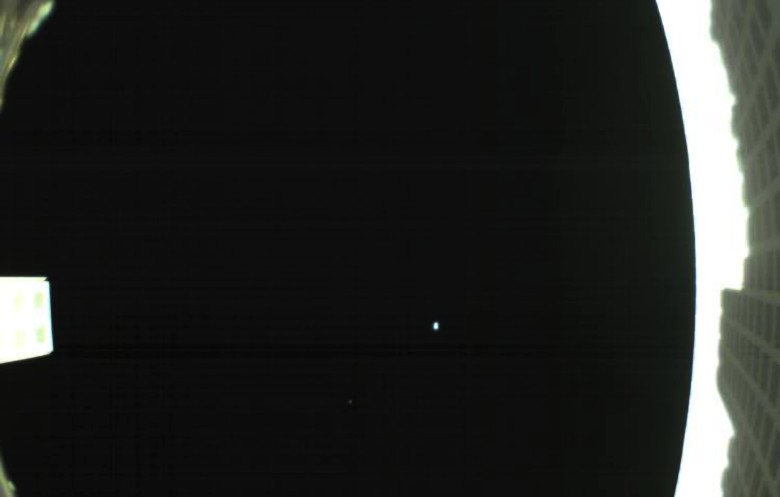Kubsat MarCO repeated the picture Pale Blue Dot

The first photo taken by one of the Mars Cube One (MarCO) satellites as part of the engineering procedure for checking the correct deployment of a narrow-beam antenna. In the center of the picture, the Earth and the Moon are visible, on the right - the deployed highly directional antenna and the shadow from the antenna power supply. On the left in the center - the antenna power supply unit, from below and above - the heat-shielding coating. Photo: NASA / JPL-Caltech. May 9, 2018
On February 14, 1990, NASA sent a command to Voyager-1 to turn around and take photographs of the planets of the solar system. One of the photographs was a classic portrait of the Earth from a distance of about 6.05 billion km. The cult picture was called Pale Blue Dot , that is, the “pale blue dot”. If you take a good look, you can see a single blue dot on a grainy photograph in the halo of sunlight, which stands out slightly from the general background. This is our home planet, the cradle of humanity.
Now a similar photo was sent by Mars Cube One (MarCO) - a cubic mini-satellite of the CubeSat class (cubsat), which is on its way to Mars. This picture was taken from a much closer distance, so that the frame can be considered separately and the Earth and the Moon. They do not merge into one pixel, as in the classic Pale Blue Dot.
Apparently, with the help of this photo, NASA celebrates a solemn event : on May 8, 2018, MarCO retired more than 1 million kilometers from Earth.
')
In fact, Mars Cube One is not one, but two identical cubic vehicles accompanying the InSight landing module sent to Mars (Interior Investigations Using Seismic Investigations, Geodesy and Heat Transport). MarCO-A and MarCO-B are the first mini-satellites of such a form factor sent beyond the limits of the earth orbit.
This image was taken with the MarCO-B, which NASA engineers affectionately call Wall-E. He used a fisheye camera and took the first frame on May 9, 2018, that is, on the fourth day after launch. Ahead of the satellites and the landing module is still a long road to the Red Planet. The photo was taken in the process of engineering verification that the narrowly directed antenna of the device was correctly developed. The specks of the Earth and the Moon became a nice bonus in the technical image.
“Consider this an expression of our respect for Voyager,” said Andy Klesh, MarCO Chief Engineer, NASA Jet Propulsion Laboratory in Pasadena California. JPL laboratory built these satellites, and now heads the mission management. - Kubsatas have never gone so far into space, so this is a major milestone. Both our Kubsat are healthy and functioning properly. We look forward to seeing even more distant frontiers. ”

NASA Engineer Checks Mars Cube One (MarCO) Satellite Before Launch
Two MarCO - the first Cubsat, ever launched into deep space. Most of these satellites never remain in orbit below 800 km above the Earth. Initially, these simple and cheap devices were designed to teach students how to design satellites, but now they are a mature commercial technology that is actively used in science and business.
The Kubsatas fly along with the ship InSight, which will attempt to land on Mars on or about November 26, 2018. As you know, every landing on the surface of Mars is a very risky event, also because of the extremely rarefied atmosphere. When InSight leaves for landing, the Kubsat will continue to monitor him and send observation data on air entry and landing to Earth.
The key element for successful broadcasting is a high gain antenna. Now the MarCO mission engineers have received confirmation that the antennas have been successfully deployed, but their testing will continue in the coming weeks.
InSight itself will not use cubsates as repeaters for transmissions to Earth. This work is assigned to another NASA orbiter, the Mars Reconnaissance Orbiter. So, in the Martian orbit, the Kubsat perform the role of trackers, testing the performance of ultra-small satellites in deep space, including the reliability of antennas, a radio transmitter, and a propulsion system.
As reported on the official website of the MarCO mission , during May, trajectory correction maneuvers are planned - these are the first such maneuvers ever performed by the Cubsat.
Source: https://habr.com/ru/post/374505/
All Articles